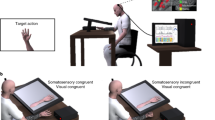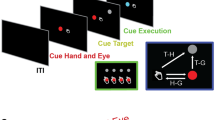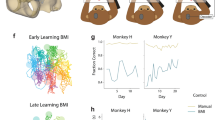Abstract
Recent technological and scientific advances have generated wide interest in the possibility of creating a brain–machine interface (BMI), particularly as a means to aid paralyzed humans in communication. Advances have been made in detecting neural signals and translating them into command signals that can control devices. We now have systems that use externally derived neural signals as a command source, and faster and potentially more flexible systems that directly use intracortical recording are being tested. Studies in behaving monkeys show that neural output from the motor cortex can be used to control computer cursors almost as effectively as a natural hand would carry out the task. Additional research findings explore the possibility of using computers to return behaviorally useful feedback information to the cortex. Although significant scientific and technological challenges remain, progress in creating useful human BMIs is accelerating.
This is a preview of subscription content, access via your institution
Access options
Subscribe to this journal
Receive 12 print issues and online access
$209.00 per year
only $17.42 per issue
Buy this article
- Purchase on Springer Link
- Instant access to full article PDF
Prices may be subject to local taxes which are calculated during checkout


Similar content being viewed by others
References
Marg, E. & Adams, J.E. Indwelling multiple micro-electrodes in the brain. Electroencephalogr. Clin. Neurophysiol. 23, 277–280 (1967).
Evarts, E.V. Pyramidal tract activity associated with a conditioned hand movement in the monkey. J. Neurophysiol. 29, 1011–1027 (1966).
Cooper, I.S. Twenty-five years of experience with physiological neurosurgery. Neurosurgery 9, 190–200 (1981).
Delgado, J.M. Physical Control of the Mind (Harper and Rowe, New York, 1969).
Benabid, A.L. et al. Deep brain stimulation for Parkinson's disease. Adv. Neurol. 86, 405–412 (2001).
Wolpaw, J.R., Birbaumer, N., McFarland, D.J., Pfurtscheller, G. & Vaughan, T.M. Brain–computer interfaces for communication and control. Clin. Neurophysiol. 113, 767–791 (2001).
Pesaran, B., Pezaris, J.S., Sahani, M., Mitra, P.P. & Andersen, R.A. Temporal structure in neuronal activity during working memory in macaque parietal cortex. Nat. Neurosci. 5, 805–811 (2002).
Donoghue, J.P., Sanes, J.N., Hatsopoulos, N.G. & Gaal, G. Neural discharge and local field potential oscillations in primate motor cortex during voluntary movements. J. Neurophysiol. 79, 159–173 (1998).
Moxon, K.A., Morizio, J., Chapin, J.K., Nicolelis, M.A. & Wolf, P.D. in Neural Prostheses for Restoration of Sensory and Motor Function (eds. Chapin, J. K. & Moxon, K. A.) 179–219 (CRC Press, Boca Raton, Florida, 2000).
Palmer, C. A microwire technique for recording single neurons in unrestrained animals. Brain Res. Bull. 3, 285–289 (1978).
Bai, Q. & Wise, K.D. Single-unit neural recording with active microelectrode arrays. IEEE Trans. Biomed. Eng. 48, 911–920 (2001).
Maynard, E.M., Nordhausen, C.T. & Normann, R.A. The Utah Intracortical Electrode Array: a recording structure for potential brain-computer interfaces. Electroencephalogr. Clin. Neurophysiol. 102, 228–239 (1997).
Rousche, P.J. et al. Flexible polyimide-based intracortical electrode arrays with bioactive capability. IEEE Trans. Biomed. Eng. 48, 361–371 (2001).
Nicolelis, M.A.L. Actions from thoughts. Nature 409, 403–407 (2001).
Maynard, E.M. et al. Neuronal interactions improve cortical population coding of movement direction. J. Neurosci. 19, 8083–8093 (1999).
Serruya, M.D., Hatsopoulos, N.G., Paninski, L., Fellows, M.R. & Donoghue, J.P. Instant neural control of a movement signal. Nature 416, 141–142 (2002).
Kennedy, P.R., Bakay, R.A., Moore, M.M., Adams, K. & Goldwaithe, J. Direct control of a computer from the human central nervous system. IEEE Trans Rehabil. Eng. 2, 198–202 (2000).
Humphrey, D.R., Schmidt, E.M. & Thompson, W.D. Predicting measures of motor performance from multiple cortical spike trains. Science 170, 758–762 (1970).
Georgopoulos, A.P. Population activity in the control of movement. Int. Rev. Neurobiol. 37, 103–119 (1994).
Taylor, D.M., Tillery, S.I. & Schwartz, A.B. Direct cortical control of 3D neuroprosthetic devices. Science 296, 1829–1832 (2002).
Wessberg, J. et al. Real-time prediction of hand trajectory by ensembles of cortical neurons in primates. Nature 408, 361–365 (2000).
Gao, Y., Black, M.J., Bienenstock, E., Shoham, S. & Donoghue, J. Probabilistic inference of hand motion from neural activity in motor cortex. Proc. Adv. Neural Info. Processing Systems 14, The MIT Press, 2002.
Romo, R., Hernandez, A., Zainos, A., Brody, C.D. & Lemus, L. Sensing without touching: psychophysical performance based on cortical microstimulation. Neuron 26, 273–278 (2000).
Talwar, S.K. et al. Rat navigation guided by remote control. Nature 417, 37–38 (2002).
Wickersham, I. & Groh, J.M. Neurophysiology: electrically evoking sensory experience. Curr. Biol. 8, R412–R414 (1998).
Dobelle, W.H. Artificial vision for the blind by connecting a television camera to the visual cortex. ASAIO J. 46, 3–9 (2000).
Hambrecht, F.T. Visual prostheses based on direct interfaces with the visual system. Baillieres Clin. Neurol. 4, 147–165 (1995).
Maynard, E.M. Visual prostheses. Annu. Rev. Biomed. Eng. 3, 145–168 (2001).
Normann, R.A., Maynard, E.M., Rousche, P.J. & Warren, D.J. A neural interface for a cortical vision prosthesis. Vision Res. 39, 2577–2587 (1999).
Schmidt, E.M. et al. Feasibility of a visual prosthesis for the blind based on intracortical microstimulation of the visual cortex. Brain 119, 507–522 (1996).
Bauby, J.-D. The Diving-Bell and the Butterfly (Knopf, New York, 1997).
Mauritz, K.H. & Peckham, H.P. Restoration of grasping functions in quadriplegic patients by functional electrical stimulation (FES). Int. J. Rehabil. Res. 10 (Suppl. 5) 57–61 (1987).
Lauer, R.T., Peckham, P.H. & Kilgore, K.L. EEG-based control of a hand grasp neuroprosthesis. Neuroreport 10, 1767–1777 (1999).
Acknowledgements
The author would like to acknowledge support from the NIH/NINDS, DARPA and the Keck Foundation.
Author information
Authors and Affiliations
Ethics declarations
Competing interests
The author is a cofounder and shareholder in Cyberkinetics, Inc., a company that is developing neural prosthetic devices.
Rights and permissions
About this article
Cite this article
Donoghue, J. Connecting cortex to machines: recent advances in brain interfaces. Nat Neurosci 5 (Suppl 11), 1085–1088 (2002). https://doi.org/10.1038/nn947
Received:
Accepted:
Published:
Issue Date:
DOI: https://doi.org/10.1038/nn947
This article is cited by
-
Machine learning-based high-frequency neuronal spike reconstruction from low-frequency and low-sampling-rate recordings
Nature Communications (2024)
-
Motor intent recognition of multi-feature fusion EEG signals by UMAP algorithm
Medical & Biological Engineering & Computing (2023)
-
Electroencephalogram based brain-computer interface: Applications, challenges, and opportunities
Multimedia Tools and Applications (2023)
-
Recognition of multi-cognitive tasks from EEG signals using EMD methods
Neural Computing and Applications (2023)
-
Brain Computer Interface-Based Signal Processing Techniques for Feature Extraction and Classification of Motor Imagery Using EEG: A Literature Review
Biomedical Materials & Devices (2023)



